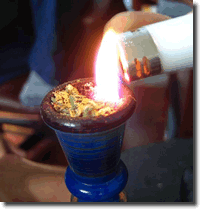
Facts About Marijuana
-
Facts about Marijuana: What is marijuana?
 Marijuana is, by far, the world’s most commonly used illicit drug—and far more dangerous than most users realize. So, there is just cause for alarm when adolescent marijuana use increases, as it did in the mid-1990’s, and the age at which youngsters first experiment with pot starts to drops.
Marijuana is, by far, the world’s most commonly used illicit drug—and far more dangerous than most users realize. So, there is just cause for alarm when adolescent marijuana use increases, as it did in the mid-1990’s, and the age at which youngsters first experiment with pot starts to drops.
Marijuana has been around for a long while. Its source, the hemp plant (cannabis sativa), was being cultivated for psychoactive properties more than 2,000 years ago. Although cannabis contains at least 400 different chemicals, its main mind-altering ingredient is THC (delta-9-tetrahydrocannabinol).The amount of THC in marijuana determines the drug’s strength, and THC levels are affected by a great many factors, including plant type, weather, soil, and time of harvest. Sophisticated cannabis cultivation of today produces high levels of THC and marijuana that is far more potent than pot of the past. THC content of marijuana, which averaged less than 1 percent in 1974, rose to an average 4 percent by 1994.
For the highly popular form of marijuana called Sinsemilla (from the Spanish "without seeds"), made from just the buds and flowering tops of female plants, THC content averages 7.5 percent and ranges as high as 24 percent. As for hashish, a resin made from flowers of the female plant, THC levels may be five to ten times higher than crude marijuana’s.
-
Facts about Marijuana: How is it used?
Marijuana and other cannabis products are usually smoked, sometimes in a pipe or water pipe, but most often in loosely rolled cigarettes known as "joints." Some users will slice open and hollow out cigars, replacing the tobacco with marijuana, to make what are called "blunts." Joints and blunts may be laced with other substances, including crack cocaine and the potent hallucinogen phencyclidine (PCP), substantially altering effects of the drug. Smoking, however, is not the sole route of administration. Marijuana can be brewed into tea or mixed in baked products (cookies or brownies).
-
Facts about Marijuana: How does it affect you?
A mild hallucinogen, marijuana has some of alcohol’s depressant and disinhibiting properties. User reaction, however, is heavily influenced by expectations and past experience, and many first-time users feel nothing at all.
Effects of smoking are generally felt within a few minutes and peak in 10 to 30 minutes. They include dry mouth and throat, increased heart rate, impaired coordination and balance, delayed reaction time, and diminished short-term memory. Moderate doses tend to induce a sense of well-being and a dreamy state of relaxation that encourages fantasies, renders some users highly suggestible, and distorts perception (making it dangerous to operate machinery, drive a car or boat, or ride a bicycle). Stronger doses prompt more intense and often disturbing reactions including paranoia and hallucinations.
Most of marijuana’s short-term effects wear off within two or three hours. The drug itself, however, tends to linger on. THC is a fat-soluble substance and will accumulate in fatty tissues in the liver, lungs, testes, and other organs. Two days after smoking marijuana, one-quarter of the THC content may still be retained. It will show up in urine tests three days after use, and traces may be picked up by sensitive blood tests two to four weeks later.
-
Facts about Marijuana: Teens and marijuana
Although dangers exist for marijuana users of all ages, risk is greatest for the young. For them, the impact of marijuana on learning is critical, and pot often proves pivotal in the failure to master vital interpersonal coping skills or make appropriate life-style choices. Thus, marijuana can inhibit maturity.
Another concern is marijuana’s role as a "gateway drug," which makes subsequent use of more potent and disabling substances more likely. The Center on Addiction and Substance Abuse at Columbia University found adolescents who smoke pot 85 times more likely to use cocaine than their non–pot smoking peers. And 60 percent of youngsters who use marijuana before they turn 15 later go on to use cocaine.
But many teens encounter serious trouble well short of the "gateway." Marijuana is, by itself, a high-risk substance for adolescents. More than adults, they are likely to be victims of automobile accidents caused by marijuana’s impact on judgment and perception. Casual sex, prompted by compromised judgment or marijuana’s disinhibiting effects, leaves them vulnerable not only to unwanted pregnancy but also to sexually transmitted diseases (STDs).
-
Facts about Marijuana: Marijuana Dangers
-
Impaired perception
-
Diminished short-term memory
-
Loss of concentration and coordination
-
Impaired judgment
-
Increased risk of accidents
-
Loss of motivation
-
Diminished inhibitions
-
Increased heart rate
-
Anxiety, panic attacks, and paranoia
-
Hallucinations
-
Damage to the respiratory, reproductive, and immune systems
-
Increased risk of cancer
-
Psychological dependency

 Marijuana is, by far, the world’s most commonly used illicit drug—and far more dangerous than most users realize. So, there is just cause for alarm when adolescent marijuana use increases, as it did in the mid-1990’s, and the age at which youngsters first experiment with pot starts to drops.
Marijuana is, by far, the world’s most commonly used illicit drug—and far more dangerous than most users realize. So, there is just cause for alarm when adolescent marijuana use increases, as it did in the mid-1990’s, and the age at which youngsters first experiment with pot starts to drops.